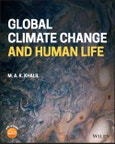In our time, the global population has become large enough to cause perceptible environmental changes all over the world. With it, a new science of global change has emerged, mostly as a practical matter to understand and manage the earth’s habitability and create a sustainable environment for some time to come - one which balances the benefits of technological and societal advances with their potential, less desirable side effects. These concerns began with the depletion of the ozone layer and its possible adverse consequences on human health, and have, in recent decades, shifted to climate change driven by ongoing global warming.
Why are these global changes occurring? How will they affect our lives? If we find the effects undesirable, what should we do? This book will attempt to answer these questions. It will show how to accomplish the goal of managing our climate, what it will take, and when it needs to be done. Such a management process has to be dynamic, making it more complex and less didactic, requiring changes in strategy to achieve a longer-term goal as our knowledge advances.
Global Climate Change and Human Life is a comprehensive and cohesive look at the emerging field of global change science. Using models that take the theoretical or conceptual understanding and translate them into mathematical forms, the book lays out a holistic view of the science that develops and teaches the main principles, concepts and conclusions. In the end, readers will be empowered to use science and the scientific method to decide how important and timely climate change is as a social issue and which solutions can succeed.
Table of Contents
Preface ix
About the Companion Website xi
1 Introduction 1
1.1 What Is Global Change Science? 1
1.2 Current Global Change 2
1.3 Raising Fundamental Questions 2
Endnotes 3
2 The Framework 5
2.1 The System 5
2.2 Scales of Action 5
2.3 What Determines Climate? 8
2.4 The Benchmark Average Climate 12
2.5 Irreducible Uncertainties 15
2.6 The Plan 16
Review of the Main Points 18
3 Atmospheric Composition 19
3.1 Trace Gases and Their Roles in Climate and the Environment 19
3.2 Quantifying the Atmospheric Composition 22
Review of the Main Points 27
Endnotes 29
4 Mass Balance Theory and Small Models 33
4.1 The Components 33
4.2 Global 35
4.3 Hemispherical and Horizontal 40
4.4 Vertical 43
Review of the Main Points 46
Endnotes 48
5 Transport Processes 51
5.1 Vertical Transport and Convection 51
5.2 Horizontal Motion and the General Circulation 56
5.3 Turbulent Transport 61
5.4 Quantifying Transport Processes 66
Review of the Main Points 69
Endnotes 70
6 Mechanisms of Sources and Sinks 73
6.1 Reservoirs and Source-Sink Relationships 74
6.2 Atmospheric Chemistry 77
6.3 Global Environmental Applications 82
6.4 Cross-Media Transport: Oceans, Soils, and Biota 90
Review of the Main Points 100
Endnotes 102
7 Balance of Climate Gases and Aerosols 107
7.1 Anthropogenic vs Natural Components 107
7.2 Greenhouse Gases 110
7.3 Aerosols 123
Review of the Main Points 126
Endnotes 127
8 The Science of Climate 131
8.1 Solar Radiation 131
8.2 Albedo 135
8.3 Radiative Transfer 137
8.4 Heat Storage and Balance 150
8.5 Precipitation 152
Review of the Main Points 154
Endnotes 156
9 Instructive Climate Models 159
9.1 Base Temperature Model - Lessons, Flaws, and Resolution 159
9.2 Radiative Forcing and Climate Sensitivity 166
9.3 Practical Relationships between Greenhouse Gases and Surface Warming 168
9.4 Role of the Oceans 171
9.5 Role of Clouds 174
9.6 Horizontal Transport of Heat 175
Review of the Main Points 178
Endnotes 180
10 Climate Feedbacks 183
10.1 How They Work 183
10.2 Feedbacks Classified and Delineated 188
10.3 Physical Feedbacks 189
10.4 Role of the Living World 192
Review of the Main Points 197
Endnotes 199
11 Match of Climate Change Observed and Modeled 201
11.1 What Is Global Warming? 201
11.2 Causes of Observed Warming 204
11.3 Differential Effects of Climate Change 207
Review of the Main Points 210
Endnotes 210
12 Population, Affluence, and Global Change 213
12.1 Basic Relationships 213
12.2 Societal Factors in Climate Change 215
12.3 Population Growth and Resources 218
12.4 Vulnerability Theory 222
Review of the Main Points 225
Endnotes 226
13 Impacts of Climate Change on Human Life 229
13.1 Impacts Classified 229
13.2 Health 230
13.3 Habitability 234
Review of the Main Points 239
Endnotes 240
14 Climate Management 243
14.1 Tragedy of the Commons 243
14.2 Compounding Forces of Resistance 248
14.3 Mechanisms for Managing the Climate 249
14.4 Geo-engineering 251
14.5 Trading Gases: The Global Warming Potential 253
Review of the Main Points 255
Endnotes 256
15 Possible Futures 257
15.1 Projections 257
15.2 The Metaphysics of Climate Change 259
Endnote 261
List of Symbols Used 263
Index 267








